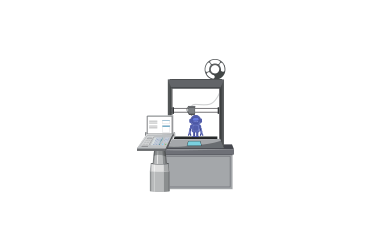
 Apr 18, 2022
Apr 18, 2022
While 3D printing has been around for decades, its popularity and usage has skyrocketed in recent years, and new 3D printing applications are constantly being developed. 3D printing applications cover various sectors from education to industry, and the entire value chain from prototyping to parts management.
As the name suggests, a 3D printer allows users to print an object as 3D CAD (Computer Aided Design) images.
Although 3D printers have been in use for more than 25 years now, they have only recently gained popularity.
Simplicity of use and nearly unlimited customization possibilities have made 3D printers increasingly popular as design tools, and because 3D technology allows for rapid printing and testing of objects for form and function, they are also called rapid prototyping.
Initially, 3D printers were used as a quick prototyping solution to make one or two quick physical samples to give designers a chance to correct defects and modify the product.
Prototyping is still the main use of 3D printers but advances in technology have made it possible to use this 3D printing beyond the research and development stages and incorporate it into the manufacturing stage.
The automotive industry has been harnessing the potential of 3D printing for decades already. 3D printing is extremely useful in rapid prototyping and has proven to be able to significantly reduce design times and lead times in new car models, and 3D printing has also increased manufacturing workflows within the industry.
With 3D printing, manufacturers can reduce lead times by up to 90% and reduce risk by integrating 3D printing processes, and by streamlining with in-house production, the overall manufacturing process becomes more efficient and profitable.
3D printing is instigate a design revolution in jewelry, and creating 3D printed pieces with a look and feel similar to handmade jewelry was a challenge.
3D jewelry printers create pieces of resin or wax, based on a 3D model of a jeweler's design, and digital models can be easily edited, making 3D jewelry prototyping incredibly cheap and convenient.
3D printing will bring back the days of having to pay exorbitant repair costs, or throw away a mostly working device, by enabling consumers to produce parts and replacement parts.
With the need to cater to all types of face shapes, eyewear is also an industry that clearly benefits from 3D printing's unlimited customization ability.
New models aimed at improving both comfort and design quality can, as elsewhere, be designed quickly, prototyped in 3D and produced at lower cost and with greater customer convenience.
The sneaker industry has always relied on technology to improve the performance of their products, and with the digital workflow, they have more options than ever in customization.
Big brands like New Balance, Adidas, and Nike, having realized the power of additive manufacturing, intend to produce custom midsoles made from 3D-printed materials.